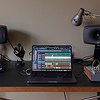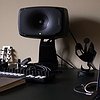Name: Mike Sheridan
Nationality: Danish
Occupation: DJ, producer
Current Release: Mike Sheridan's Atmospherics is out November 17th 2023 via hfn.
Recommendations: Nicolai Howalt is a danish visual artist. He did the artwork for ATMOSPHERICS and has become a friend. As a huge fan of his work, I’d like to recommend anyone with an interest in photography to check out his work.
Alexander Tillegreen is my close friend who has his amazing debut album In Words coming out on Raster soon. Alexander works as both a visual artist and in music, the two influencing each other, and both sides are equally inspiring.
If you enjoyed this Mike Sheridan interview and would like to stay up to date with his music, visit his official homepage. He is also on Instagram, Facebook, and twitter.
Do you think that some of your earliest musical experiences planted a seed for your interest in production and technology?
Definitely. My way into music was very technological. My dad installed a demo version of Sony’s ACID on my PC tower in 1998.
What were your very first active steps with music technology and how would you rate the gains made through experience - can one train/learn being an artist/producer?
I started quite young, at 9 years old, with my PC and ACID. After rearranging all the demo songs, I found out how to import other sounds into the thing.
Simultaneously, I became obsessed with turntablism - because DJing is like the coolest thing right? I went to learn how to DJ at a music school and learned to crab-scratch and beatmix on vinyl LPs.
It was a safe space for trial and error and we got to play shows for friends and family. It was so much fun.
Making music, in the beginning, is often playful and about discovery. How do you retain a sense of playfulness as things become more professionalised and how do you still draw surprises from equipment you may be very familiar with?
You can be professionally playful. It’s the practice and discipline in my life - keeping it playful. This radiates into time mangement, planning and executing processes and mental health.
I think of my primary occupation as an artist is to interface my life so that I’m able to be creative and to protect that ability.
For your own creativity, what is the balance and relative importance between what you learned from teachers, tutorials and other producers on the one hand – and what you discovered, understood, and achieved yourself? What are examples for both of these?
It’s a strange question for me, because I hear music in my mind. Everything I do as an artist attempts to make my inner soundscape tangible - which makes me a terrible student in so many ways.
Palle Mikkelborg is a dear friend who took on a mentoring role for me and from whom I learned how to be myself as musician. I am dyscalculic, which unfortunately complicates music theory for me, as I simply can’t practically read it. This has made it vastly difficult for me to learn to play music.
With Palle, we never talk about the music we play, it’s different because it seems we’re just able to play it. I developed as an improviser because Palle understood that what we do together is not about music - music is the by-product of how we listen to each other. 
Mike Sheridan Work Space Image (c) the artist
How and for what reasons has your music set-up evolved over the years and what are currently some of the most important pieces of gear and software for you?
I radically simplified my setup in the past years. My core gear is now a 14” MacBook Pro, my RME Fireface UCX and a pair of Genelec 8331.
I have 2 synthesizers; an Intellijel Cascadia and the UDO Super 6, two drum machines; A Pulsar 23 and a Digitakt. The Cristal Baschet and electric guitar are instrumental constants for me as well and I spend time with these as well daily.
I am looking to find a personal balance between the digital, analogue and acoustic.
Have there been technologies which have profoundly influenced, changed or questioned the way you make music?
I was greatly affected by working in a big studio about ten years ago and how it was designed for recording to tape. It settled some things for me in terms of process. I felt I’d hit the wall in terms of what I could do with Ableton so I learned Pro Tools and how to record to tape.
Understanding analogue workflows gave my work a greater capacity beyond the one window DAW that I was used to.
Yann Tiersen, in a surprising statement, told me: "I feel more sincere with electronic instruments [than acoustic ones]." Is that something you can relate to?
The experience of playing acoustic instruments can feel so weighed down by tradition. It’s so problematic and can be really discouraging.
The inventors of the Cristal, Bernard and Francois Baschet, exhibited their sound-sculptures and always had a sign saying “Please Play”. Instead of the visitors standing in awe, afraid to touch, people would get to interact with something strange and wonderful and have a personal moment to resonate.
Late producer SOPHIE said: “You have the possibility with electronic music to generate any texture, and any sound. So why would any musician want to limit themselves?” What's your take on that and the relevance of limitations in your set-up and process?
I’m setting out to do a personal project just with instruments I can “touch”. I have made these sound-stations with the instruments I mentioned.
I picked it up from an interview with Daniel Lanois, who I really admire. He talks about his stations, combinations of equipment that he likes, and that really resonated with me.
From the earliest sketches to the finished piece, what does your current production workflow/process look like?
I collage sounds in Ableton or record in Pro Tools. I never work with templates. I play my instruments, and the synths can be quickly hooked up and bleep in sync. The ideas I like the most are exported as multitracks into Pro Tools for editing and arranging. I might record new parts, plan a certain experiment or book studio session out in town, seek a collaboration, and so on.
In the case of ATMOSPHERICS, the 10 songs spent about a year in Pro Tools after the writing phase in Ableton, and I worked on them side by side with more or less the same instrumentarium and processors. I felt that the album achieved coherence that way.
Mixing took about two months and was done digitally - since 90% of the album was recorded from analog sources, I didn’t feel it needed an analogue mix as well - the mastering was done as a hybrid analogue / digital stem mastering.
Rhythm, sound design, melody/harmony, something else – when do the different elements of a piece come into play for you?
Most of my studio practise is making tools for composition. I work concentrated on rhythm, melodies and textures separately or in very simple combinations.
There will be particular combinations that work better than others, and so that informs which ones will be developed further.
Mike Sheridan Work Space Image (c) the artist
In relation to sound, one often reads words like “material”, “sculpting”, and “design”. How does your own way of working with sound look like? Do you find using presets lazy?
For many of the songs on ATMOSPHERICS I took my recordings and put them through 2 1980s Korg SDD 1000. I recorded the 100% wet output of their longest delay time. The longest time only being available when the machine clocks to a lower samplerate made for this shadowy low-res feeling.
Doing that gave the vertical axis of the songs a sense that some elements are happening in a different light or era than the rest of the song, distances somehow. I play around with resolution like that more and more in my work.
What, to you, are the respective benefits of solo work and collaborations and do you often feel lonely in the studio? Can machines act as collaborators to you?
I like to think about collaboration as giving gifts to each other. A collaboration can start anywhere; as a conversation, as an exchange of sounds, listening, writing … Having a stake in other artists work is a truly amazing thing, and vice versa.
I find when collaborations simply doesn’t work out or when professionalism breaks down - there is always an opportunity to grow.
To some, the advent of AI and 'intelligent' composing tools offers potential for machines to contribute to the creative process. What are your hopes, fears, expectations and possible concrete plans in this regard?
I would definitely like to have a personal AI! I’d feed it my sounds, works, techniques.
It would be inspiring to see if I can confront this machine version of “myself” and see how far I can push my idea of personal expression.






